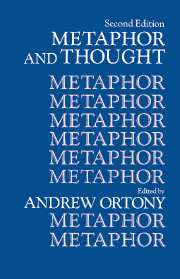Book contents
- Frontmatter
- Contents
- List of contributors
- Preface to the second edition
- Preface to the first edition
- 1 Metaphor, language, and thought
- METAPHOR AND MEANING
- METAPHOR AND REPRESENTATION
- METAPHOR AND UNDERSTANDING
- 14 Psychological processes in metaphor comprehension and memory
- 15 The interpretation of novel metaphors
- 16 The role of similarity in similes and metaphors
- 17 Images and models, similes and metaphors
- 18 How metaphors work
- 19 Metaphor and irony: Two levels of understanding
- METAPHOR AND SCIENCE
- METAPHOR AND EDUCATION
- References
- Author index
- Subject index
18 - How metaphors work
Published online by Cambridge University Press: 05 June 2012
- Frontmatter
- Contents
- List of contributors
- Preface to the second edition
- Preface to the first edition
- 1 Metaphor, language, and thought
- METAPHOR AND MEANING
- METAPHOR AND REPRESENTATION
- METAPHOR AND UNDERSTANDING
- 14 Psychological processes in metaphor comprehension and memory
- 15 The interpretation of novel metaphors
- 16 The role of similarity in similes and metaphors
- 17 Images and models, similes and metaphors
- 18 How metaphors work
- 19 Metaphor and irony: Two levels of understanding
- METAPHOR AND SCIENCE
- METAPHOR AND EDUCATION
- References
- Author index
- Subject index
Summary
In his contribution to this volume, Searle asks, “why do we use expressions metaphorically instead of saying exactly and literally what we mean?” We propose that this question seriously misstates the nature of the problem. We will argue that when people use metaphors, they are saying exactly what they mean. When, for example, someone says that “Sam is a pig,” that is precisely what is meant; that the person designated by the name “Sam” is a member of a superordinate category referred to by the word “pig” (Glucksberg & Keysar, 1990). To understand how metaphors of this type work requires an understanding of at least two processes. First, what is the nature of the category formed by the assertion that S is P? Second, what governs the choice of the metaphor vehicle, P, as a name for that category? Answers to these pivotal questions will provide answers to other questions about how metaphors work, including the question posed by Searle, why do we use metaphors at all? What communicative functions do metaphors serve in discourse that are not served by more or less comparable literal expressions?
We will first examine in detail how metaphors are understood. We will begin with an analysis of the standard pragmatics view of how people understand utterances that are intended nonliterally. The pragmatics view rests on the assumption that literal meanings have unconditional priority in language use.
Information
- Type
- Chapter
- Information
- Metaphor and Thought , pp. 401 - 424Publisher: Cambridge University PressPrint publication year: 1993
Accessibility standard: Unknown
Why this information is here
This section outlines the accessibility features of this content - including support for screen readers, full keyboard navigation and high-contrast display options. This may not be relevant for you.Accessibility Information
- 116
- Cited by
